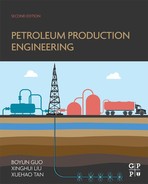Book Description
Petroleum Production Engineering, Second Edition, updates both the new and veteran engineer on how to employ day-to-day production fundamentals to solve real-world challenges with modern technology. Enhanced to include equations and references with today’s more complex systems, such as working with horizontal wells, workovers, and an entire new section of chapters dedicated to flow assurance, this go-to reference remains the most all-inclusive source for answering all upstream and midstream production issues.
Completely updated with five sections covering the entire production spectrum, including well productivity, equipment and facilities, well stimulation and workover, artificial lift methods, and flow assurance, this updated edition continues to deliver the most practical applied production techniques, answers, and methods for today’s production engineer and manager.
In addition, updated Excel spreadsheets that cover the most critical production equations from the book are included for download.
- Updated to cover today’s critical production challenges, such as flow assurance, horizontal and multi-lateral wells, and workovers
- Guides users from theory to practical application with the help of over 50 online Excel spreadsheets that contain basic production equations, such as gas lift potential, multilateral gas well deliverability, and production forecasting
- Delivers an all-inclusive product with real-world answers for training or quick look up solutions for the entire petroleum production spectrum
